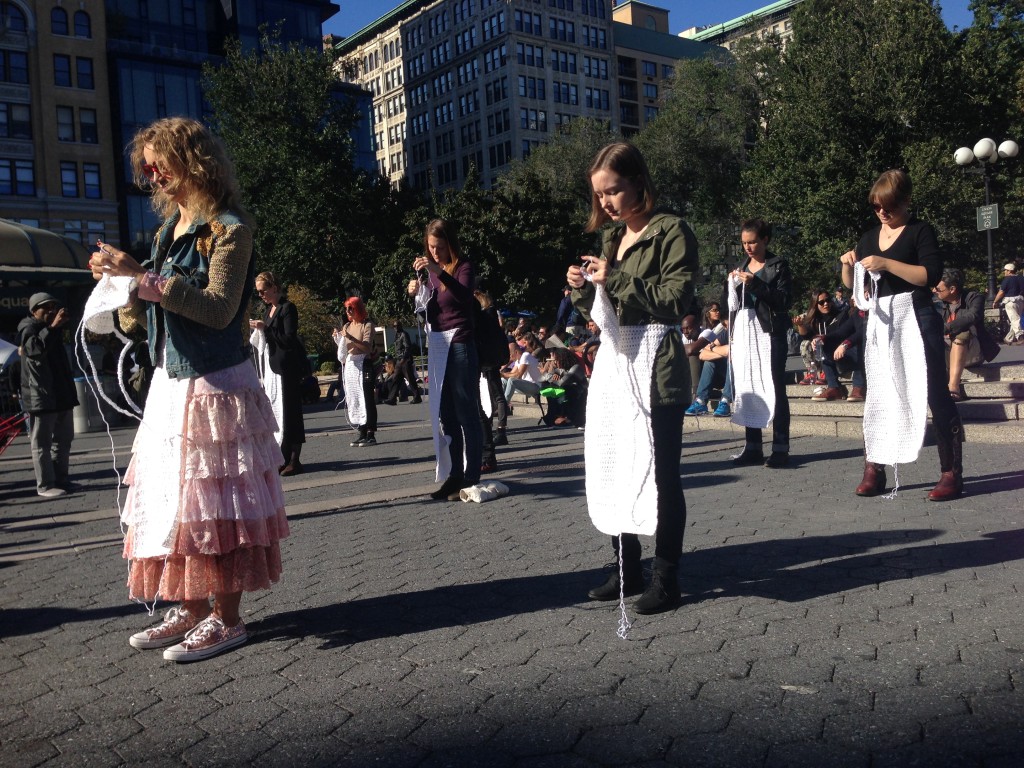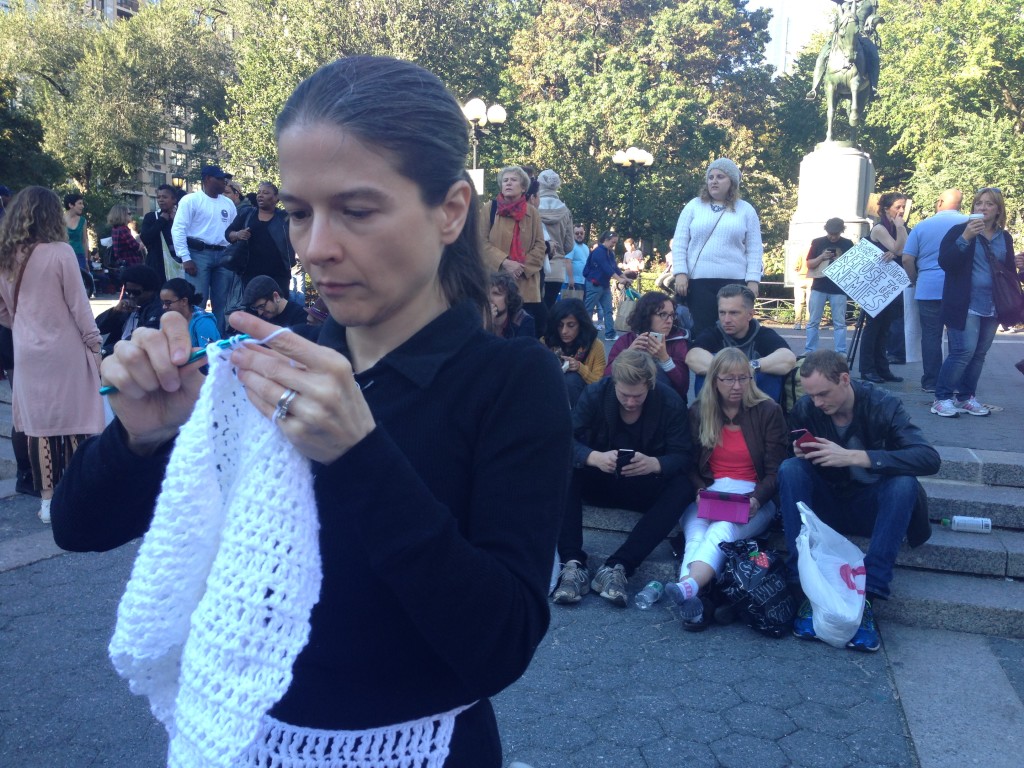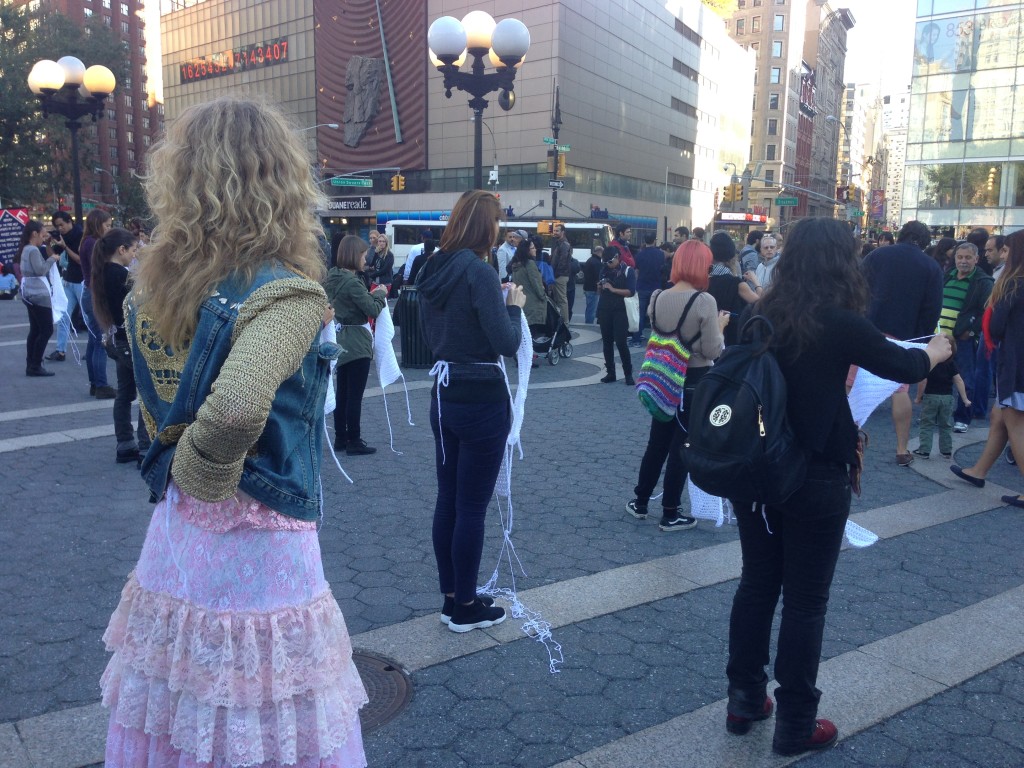Seen and Unseen: The (In)visible Entanglement of Femininity and Labor
New York City is in flux, it always has been. From the high to the low to the middling, the city fails to find a stable pulse. In these moments of flux, the in-between spaces—where public and private blur—are no longer oddities. Instead, oddities begin to populate these in-between, public spaces in a rather rhizomatic way–learning takes place. In this way, entry and exit points are varied, eschewing hierarchies at every turn, and offering no clear-cut narrative. This is 14th Street in a nutshell…or what it has become.
The intent of Art in Odd Places, RECALL is to capture this transformative flux through artist installations, interventions, and performance along the 14th Street corridor. To celebrate the street and Art in Odd Places’ odd-numbered 11th anniversary, Reisman and Henry surveyed the past 500 or so artists that have staged odd artworks along 14th Street over the past ten years. Forty-seven past artists made the cut. And the projects were truly offbeat, but that was expected. Where Leah Harper’s Complimentary (2014) gumball machine of platitudes prompted passersby to linger a little longer on 14th Street, Yoko Inoue’s free subway rides in 18 Minute Interval Swipe (2009) shuttled people away from the bustling thoroughfare of 14th Street. This coming and going may suggest an order to the flow or reception of Art in Odd Places, but it’s anything but that. Instead, Art in Odd Places, RECALL defies predictability in a paradoxical sense, seizing on the sentiment that our memory for things can be fleeting yet formative. Recall is difficult, all the more so when we’re bombarded with mechanical reproductions of things. Memories ensconced within this cycle of reproduction soon become monuments, no longer able to find a formative place to transgress realities. RECALL—especially the performances—offers these memories another outlet, a transgressive (after)life. By revisiting these singular encounters in the physical, the performative works of, say, Olek in Working Woman (2015) trigger a transgressive tone to bygone memories of femininity, domesticity, material labor, and the practical value of these in embodied concepts in the here-and-now.
So it’s 3 pm, Saturday, October 10, 2015. The lull of midafternoon begins to set. Bodies move about, languid and loud. Pedestrians and performers populate the space. Then fourteen women appear. Not immediately though. They come quite subtly, a phantasma of sorts, with no real register of their presence. The square is teeming with activity anyway; there is not much ado to them…these fourteen women. White, crocheted aprons hang listlessly from their waists. In some cases, lose threads of yarn drag on the floor. An oddity perhaps, but it doesn’t resonate as such; the spatial context—Union Square—is known for the uncanny, those familiar moments with a dash of random absurdity. Staggered in arrival, the women still seem nondescript, bonded through these matronly aprons. A triangular pattern soon forms amongst the women. Olek stands at the front, the apex of the arrangement. The others fall in line, in rank, ready. Then it begins: each woman, initially aimless in appearance, launches into a syncopated movement of crocheting. From still to strident, the women aggress upon these crocheted aprons in symbiotic unison. Heads are down, concentrating on the work at hand.
A crowd starts to gather, mesmerized at the happening. However, it’s not immediately clear what is happening. That the women are working is an obvious. Over the next ten minutes the women maintain a diligence about them, busily unraveling their aprons. The majority of the women zero in on what’s before them, eyes rarely meeting with onlookers. Olek looks about, however, cheekily glancing out at the crowd. The Polish-born, Brooklyn-based Olek is playfully known as the art world’s ‘bad girl of yarn’. Obliging her title, Olek performs for the camera, offering a coy smile and occasional eye contact, and then reverting to a seriousness that smacks as indifference. All the while her pace is blistering, her dexterous hands manipulating the crochet hook with aplomb. Some women are more labored in their efforts; others show an equally breakneck pace. Despite this, the women’s carefully mirrored movements and triangular form convey a sense of equality. At times, Olek shifts her locus to the base of the triangle, gesturing towards another woman to stand in at the apex. She returns to the front again, assuming her mantle as maestro over her chorus, only to appoint a new figurehead after several minutes.
As the performance nears forty minutes, murmurings begin to fill the audience. Interestingly, only men approach the women, leaning in to probe, to pry, even to philander. “Why don’t they speak to me? I just want to know what’s going on,” one man asks me. Another appears to whisper come-ons into a woman’s ear. Embarrassed, she cracks a controlled yet confident smile, and continues to unravel her apron. Defeated, he walks off to another woman who completely ignores him. It slowly sinks in that nothing will budge these women. Second after second, minute after minute, for the entire one hour of the performance, the women dutifully deconstruct their aprons only to rework the straggly yarn into another apron—breaking down to build anew. In its cyclical form, Working Woman (2015) is a nod to the never-ending work of women.
But Working Woman goes beyond the repetitive, cycle of things—that’s too pedestrian of a read. Commerce enveloped Working Woman and this public playground of Union Square, with the surrounds of the performance circling back to the leitmotif of labor. Citibank and Bank of America held court at the extreme ends of the block; Forever 21, Whole Foods, and MAC Cosmetics fell in between. Shoppers streamed in and out of these stores, obeying the capitalist dictum of the courts. Against this backdrop of consumer capitalism, Olek turned to Working Woman to ask tough questions on charting the cartography of labor, particularly in this post-Fordist era where material forms of labor vie up against immaterial. Where does labor begin and end? How do we factor in practical versus symbolic value of labor? And how does the feminist front figure into this mapping?
It’s interesting to consider these questions with the knowledge that prior iterations of Working Woman involved Olek performing solo. In staging her performance for RECALL, Olek was quite adamant about including (and compensating) other women to crochet alongside her. In the end, she decidedly deviates from this lone-warrior template. Woman becomes women. One becomes fourteen. Union Square is a markedly different context to the quiet nook of a Polish gallery (Working Woman in White, 2009) or the relatively low-key Pariser Platz in Berlin (Working Woman in Red, 2010). Alone, Olek’s labors would have felt anachronistic, dwarfed by the animated pulse of Union Square and transformative agenda of RECALL. In point, her solo efforts felt apt in those ‘quieter’ corners of the world; Union Square, however, called for an expansive restaging in order to realize not just the sociopolitical undertones in Working Woman specific to Union Square, but to memorize this moment for future recall. Few will forget what they witnessed. Together, Olek and these thirteen women fenced with the commerce and crowds bustling about. It was a testament to the collective over the individual, experience over commerce, material over immaterial. Power structures shifted for a moment in this restaging of the work, and much has to be said about the artist-as-curator approach that seemed to emerge here. Thinking beyond her own physical body, Olek, through Working Women, ensured that female bodies were not docile social agents even in the face of overwhelming consumerism. Their silence spoke volumes; the curatorial shift proving how domesticity and material labor, propped up by a female form, can take center stage, for just a moment, in this dog-eat-dog, commercial and creative epicenter of Union Square.





